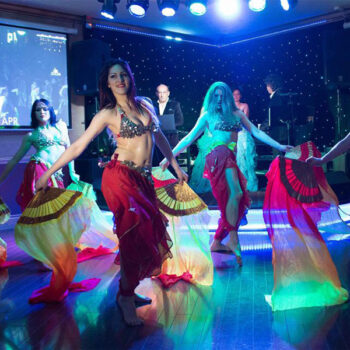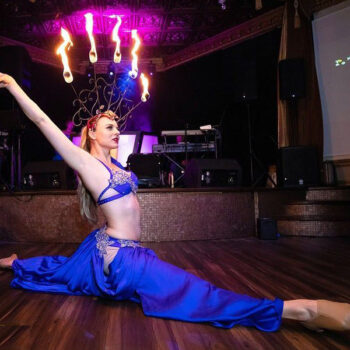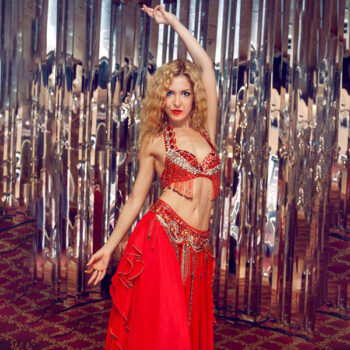Belly Dance: A Rich and Vibrant Art Form
Belly dancing is a special kind of cultural activity that fascinates people all over the world. Its mesmerizing exotic style has sparked the imagination of countless people. In this article, we discuss the history of belly dance, different styles and sub-genres, as well as the cultural significance of this type of dance. You will learn what is belly dance and what is included in the list of belly dance styles.
What style of dance is belly dancing?
Belly dances definition centers around a dance style that emphasizes the beauty of the human body. This type of dance is usually accompanied by mesmerizing music that complements the story of the dancers. Belly dance is characterized by graceful, undulating movements of the chest, arms, and hips, often adorned with flowing fabric and decorative accents.
What is traditional belly dancing called?
This term encompasses the wide variety of styles and techniques used in belly dances, including Turkish, Egyptian, Lebanese, and more. What is the belly dance meaning and where does it originate from? While the origins of this dance form are shrouded in mystery, it is believed to have been used as a form of ritualistic fertility dance in ancient times. Today, belly dances examples are often associated with sensuality and femininity, but it remains an important cultural art form in many countries.
One key aspect of traditional belly dancing is the music that accompanies it. Belly style dance music typically features a combination of Middle Eastern instruments such as the oud, tabla, and doumbek, as well as Western instruments like the violin and accordion. The rhythms and melodies of this music are intricately tied to the movements of the dance, creating a harmonious and captivating performance.
Whether you're a seasoned belly dancer or simply a fan of the art form, understanding the traditional dance genre can deepen your appreciation for this beautiful and complex dance.
Origins of Dance Belly
Belly dance origin remains unclear, but it is believed to have been used as a form of ritualistic fertility dance in ancient times. Over the years, it has evolved into a diverse and multi-faceted art form with many different belly dance style names and variations, each with its own unique flavor and cultural influences.
In general, belly dance emphasizes the natural curves and movements of the body, with a focus on fluidity and grace. It is often performed solo or in groups, and can be accompanied by a variety of musical styles including traditional Middle Eastern rhythms, modern pop music, or fusion blends that incorporate elements from various cultures.
One of the most intriguing aspects of belly dance is its ability to transcend cultural boundaries and bring people together through a shared love of dance and music. Whether you're a seasoned belly dancer or simply a fan of the art form, there is always something new to discover and appreciate about this beautiful and enchanting dance style.
Costumes for Belly Dance
Belly dance costumes come in a wide variety of styles and designs, but they all share one common characteristic: they are designed to accentuate the dancer's movements and curves. One of the most iconic elements of belly dance costumes is the hip scarf or belt, which is often adorned with coins, beads, or tassels that create a mesmerizing sound as the dancer moves. Many belly dance costumes also feature intricate embroidery, sequins, and other embellishments that add an extra layer of visual interest to the costume and help to catch the light and create a dazzling effect on stage.
Let's take a look at some of the most popular belly dance costume styles:
- Bedlah: This is the most classic and traditional cabaret style of a belly dance costume. It typically includes a bra top, a hip belt, and a skirt or harem pants. The bra top is often embellished with coins or intricate beadwork, while the hip belt may feature tassels, fringe, or additional beading. The skirt or harem pants are typically made of light and flowing fabrics and may have slits to showcase the dancer's leg movements.
- Baladi Dress: Originally a traditional dress worn by Egyptian women, the baladi dress has been adapted for belly dance performances. The dress often features a fitted bodice, a full skirt, and flared sleeves. The dress may be decorated with embroidery or beading and may have a slit in the skirt for ease of movement.
- Saidi Dress: The Saidi dress is a traditional dress worn by women in the Upper Egypt region, and has also been adapted for belly dance performances. Similar to the Baladi dress, it features a fitted bodice, and a full skirt, and may have a long veil or shawl. The dress is often adorned with embroidery and may have tassels or fringe on the skirt.
- Tribal Costume: Tribal belly dance is a modern fusion of traditional belly dance with other dance genres, such as flamenco and Indian dance. Tribal costumes are often layered with fabrics, belts, and jewelry, and typically feature earthy tones such as brown, green, and blue.
Choosing the Right Costume
The reason why belly dancers are so meticulous in choosing their costumes is that they are an essential part of the performance. Belly style dance costumes are designed to highlight the curves and movements of the dancer's body, emphasizing the beauty and sensuality of the dance.
Belly dance costumes are known for their intricate embroidery, dazzling sequins, and vibrant colors. From the rich jewel tones of the Egyptian style to the bold and playful patterns of the Turkish style, each costume is a work of art that reflects the dancer's personality and style.
The beauty of belly dance costumes is not limited to just the colors and patterns, but also to the way they move. Many costumes feature flowing skirts or harem pants that swish and sway with the dancer's every move, adding an extra layer of visual interest to the performance.
In summary, belly dance costumes are an integral part of the dance form and are just as important as the movements themselves. With their vibrant colors, intricate designs, and flowing fabrics, they are a beautiful and mesmerizing addition to any belly dance performance.
Different Styles of Belly Dance
Today there are many types of belly dance styles, each of which has its unique flavor and characteristics. Let's learn more about what a belly dance means and what is belly dance style.
Egyptian Belly Dance
Egyptian style belly dance is known for its graceful and fluid movements that emphasize the hips and torso. The dance style has a long and rich history, dating back to ancient times. Egyptian belly dance is characterized by an intricate layering of movements, including shimmies, undulations, and figure-eight motions. It is often performed in traditional Arabic music, which features a variety of percussion instruments and melodic vocals. Egyptian belly dance has inspired many other styles of belly dance and continues to be a popular style today.
Turkish Belly Dance
Turkish belly dance is a lively and energetic style that emphasizes fast and intricate movements. It features a lot of hip and chest isolations, as well as fast shimmies and spins. Turkish belly dance is often accompanied by lively and upbeat music, such as Turkish folk music or modern pop songs. The costumes for Turkish belly dance are typically brightly colored and feature lots of fringe and sequins. Turkish belly dance is a fun and high-energy style such as folk dances that is sure to get the audience on their feet.
Lebanese Belly Dance
Lebanese belly dance is a sensual and romantic style that emphasizes fluid and graceful movements. It is characterized by a lot of hip and torso undulations, as well as delicate arm and hand movements. Lebanese belly dance is often accompanied by slow and melodic music, such as Lebanese folk songs or classical Arabic music. The costumes for Lebanese belly dance are typically flowy and elegant, often featuring long skirts or veils. Lebanese belly dance is a beautiful and emotive style that is sure to captivate the audience.
American Tribal Style (ATS)
American Tribal Style (ATS) is a modern style of belly dance that was created in the 1970s. It is a fusion of traditional belly dance moves with influences from other dance styles, such as flamenco and Indian classical dance. Tribal-style belly dance is characterized by a strong group dynamic, with dancers often improvising movements together. It is often performed to a fusion of music styles, such as Middle Eastern rhythms with modern electronic beats. The costumes for ATS are often inspired by tribal cultures from around the world, featuring lots of earthy colors and natural materials.
Fusion Belly Dance
Fusion is a modern style that combines elements of traditional dance with other popular belly dance styles, such as contemporary dance, hip-hop or jazz dance. It is a highly creative and experimental style that allows dancers to incorporate their unique influences and ideas into their performances. Fusion belly dance is often performed in a variety of music styles, from traditional Arabic music to modern pop songs.
In conclusion, belly dance is a beautiful and captivating dance style that has a rich history and cultural significance. From its traditional roots in the Middle East to its modern incarnations, belly dance continues to inspire dancers and audiences alike. All belly dance styles share a common emphasis on fluid and graceful movements of the hips and torso, as well as a deep connection to the music. Whether performing traditional Middle Eastern rhythms or modern electronic beats, belly modern dance has something to offer for everyone. Ultimately, the meaning of belly dance goes beyond just the physical movements; it is a celebration of femininity, strength, and artistic expression. Learn more about this culture, how to dance belly style and join the belly dance community.




